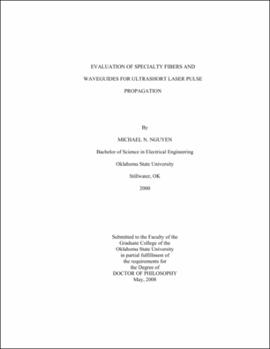| dc.contributor.advisor | Church, Kenneth H. | |
| dc.contributor.author | Nguyen, Michael N. | |
| dc.date.accessioned | 2013-12-10T18:05:50Z | |
| dc.date.available | 2013-12-10T18:05:50Z | |
| dc.date.issued | 2008-05 | |
| dc.identifier.uri | https://hdl.handle.net/11244/7865 | |
| dc.description.abstract | Ultrashort pulse lasers have become invaluable tools in many areas of science and technology. Optical waveguide or fiber delivery of ultrashort pulses would benefit numerous applications that require remote location of the laser or for addressing areas of low accessibility such as minimally invasive surgical procedures, multiphoton excitation microscopy, laser micromachining and high bandwidth telecommunications. However, the extremely high peak power and bandwidth associated with ultrashort pulses are prohibitive for most conventional waveguides that guide light in solid dielectric cores, the main drawbacks being dispersion, nonlinear effects, and damage via optical breakdown. The purpose of this study is to investigate the significant obstacles involved with implementing optical waveguides or fibers capable of delivering ultrashort pulses. | |
| dc.description.abstract | In recent years, specialty fibers such as large mode-area (LMA) photonic crystal and photonic bandgap fibers have been developed, which exhibit remarkable properties such as single-mode guidance that is independent of core size and guidance in an air core respectively. In this thesis, two early prototypes of each of these fibers are investigated for their ability to deliver ultrashort pulses. Another specialty fiber, silver coated hollow silica waveguide, which was originally developed for delivery of infrared light from CO2 and Er:YAG lasers is shown to be a good candidate for single-mode delivery of gigawatt peak power pulses with minimal pulse distortion. | |
| dc.description.abstract | Another potential fiber is comprised of multiple evanescently-coupled single-mode cores. This so-called multi-core fiber has demonstrated increased power handling in fiber lasers and amplifiers and was selected as a candidate for delivery of ultrashort pulses due to its scalable large mode-area and increased nonlinear threshold. A design for multi-core fibers is proposed that allows tailoring of the supermode distribution to obtain equal power distribution among all cores, thereby maximizing power handling. The design is analyzed numerically using a Scattering Matrix Method (SMM) and coupled-mode analysis. Experimental verification of the proposed supermode tailoring method is achieved with femtosecond pulse direct-written waveguide arrays in soda-lime glass and high-purity fused silica. Experimental results of direct-written waveguide arrays are in excellent agreement with SMM and coupled-mode simulations and verify the ability to tailor supermodes in these structures by controlling a single variable during fabrication. | |
| dc.format | application/pdf | |
| dc.language | en_US | |
| dc.rights | Copyright is held by the author who has granted the Oklahoma State University Library the non-exclusive right to share this material in its institutional repository. Contact Digital Library Services at lib-dls@okstate.edu or 405-744-9161 for the permission policy on the use, reproduction or distribution of this material. | |
| dc.title | Evaluation of specialty fibers and waveguides for ultrashort laser pulse propagation | |
| dc.contributor.committeeMember | Cheville, Alan | |
| dc.contributor.committeeMember | Westhaus, Paul A. | |
| dc.contributor.committeeMember | Wicksted, James P. | |
| osu.filename | Nguyen_okstate_0664D_2641.pdf | |
| osu.accesstype | Open Access | |
| dc.type.genre | Dissertation | |
| dc.type.material | Text | |
| thesis.degree.discipline | Physics | |
| thesis.degree.grantor | Oklahoma State University | |
